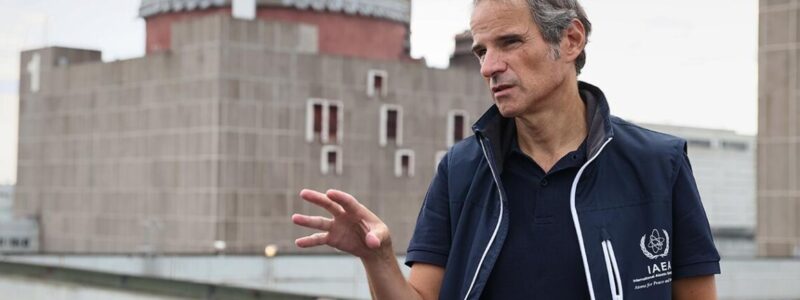
International Atomic Energy Agency (IAEA) Director General Rafael Grossi is planning a third visit to the Russian-occupied Zaporizhzhia NPP in the near future after the full-scale invasion.
“With the establishment of the five principles and my intention to report any violations, it is important that I go to the plant again to assess developments since my last visit in late March,” said Grossi, quoted in a statement on the IAEA website Friday evening.
He expressed concern about several developments at ZNPP. First of all, this is the absence of reserve power lines to supply the plant for its own needs, although there were four of them before the war.
At the same time, the head of the IAEA noted that ZNPP had been relying on the only functioning 750 kV power line for three months already, after its failure, as it happened last time on May 22, the largest nuclear power plant in Europe was forced to switch to emergency diesel generators.
He added that Ukraine cannot repair the 330 kV transmission line located in its controlled territory that was damaged on March 1 because of military operations, and the Russian Federation also has not repaired the open 330 kV switchyard at the Russian-controlled Zaporizhzhya TPP adjacent to ZNPP in order to restore the other three 330 kV lines.
“The IAEA team of experts who are at ZNPP have not yet been granted access to ZNPP to assess the situation, despite Rosatom’s assurance that they would be able to go there. Consultations are continuing to ensure access. Our experts need to see with their own eyes what the current situation looks like and whether it is possible to restore the backup power supply there,” stressed Grossi.
According to Grossi, the tense situation at the ZNPP is underscored in particular by the mine explosions near its site, which were reported by the IAEA team last week, as well as the May 17 disruption of automatic data transmission from eight radiation monitoring stations located near the plant.
He explained that Ukraine provides data to the IAEA’s International Radiation Monitoring Information System (IRMIS), which collects near real-time radiation monitoring data from more than 6,000 stations worldwide. In the absence of automatic communication, daily radiation monitoring data from eight stations are provided to the IAEA team at ZNPP and subsequently made public on IRMIS.
According to Grossi, he told the Ukrainian authorities that the IAEA was dealing with the issue with the plant management and the relevant officials.
He also noted that the planned rotation of the current IAEA expert team – the eighth since the mission was established last September – had been postponed due to local weather conditions. At the same time, new teams of IAEA experts arrived at all Ukrainian-controlled nuclear power plants, including the Chernobyl plant.
In general, describing the situation at Ukrainian nuclear power plants, the Head of the IAEA pointed out that the reactor of the Pivdenno-Ukrainian Nuclear Power Plant, which was stopped on May 22, had returned to its full capacity. In addition, he noted that the transportation of spent nuclear fuel to the centralized storage facility in the Chernobyl zone had been resumed. At the same time, he noted that on May 29, an unmanned aerial vehicle was detected near the Khmelnytskyi nuclear power plant.
Grosi also confirmed that within the framework of the comprehensive medical assistance program implemented by the agency, including psychological support, the IAEA experts would deliver necessary medical equipment to several nuclear power plants.
In addition, he said, the IAEA has arranged two more deliveries of equipment for nuclear power plants in recent days, this time of satellite communication systems, antennas and spectrometers, made possible by contributions from Britain and the United States.
“With 18 deliveries since the beginning of military operations, the IAEA has facilitated a package of international assistance to Ukraine totaling EUR5 million in support of nuclear safety,” Grossi concluded.
As reported, at the end of May the head of the IAEA proposed 5 safety principles for the Zaporizhzhia NPP
First, the ZNPP should not be used as a storage facility or a base for storing heavy weapons (i.e., MLRS, artillery systems and ammunition, tanks) or military personnel that could be used for an attack from the plant.
Second, there should be no attacks from or against the plant, in particular on reactors, spent fuel storage facilities, other critical infrastructure or personnel.
The third principle is to eliminate the risk of loss of external power supply, for which it must be made available and safe.
Fourth – all structures, systems, and elements necessary for safe and reliable operation of ZNPP must be protected against encroachments or acts of sabotage.
As a fifth principle, he pointed out that no actions should be taken that undermine the above principles.
He said he formed this set as a result of intensive consultations with Ukrainian leadership as well as Russia.
On June 2, the Ukrainian State Nuclear Regulatory Inspectorate (SNRIU) reported that Russian hijackers had blocked the transmission of information from the Automated Radiation Situation Monitoring System (ARMS) of the Zaporizhzhia NPP that they occupied.